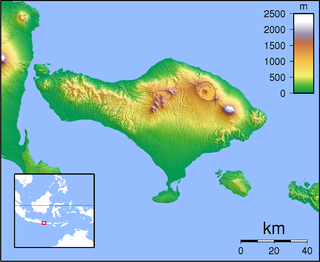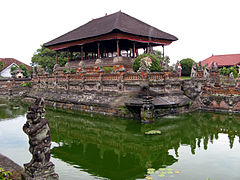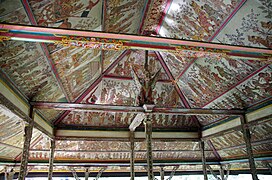
Raja is a royal Sanskrit title used for Indian monarchs. The title is equivalent to king or princely ruler in the Indian subcontinent and Southeast Asia.

Klungkung Regency is the smallest regency (kabupaten) in the island province of Bali, Indonesia. It has an area of 315 km2 and had a population at the 2010 Census of 170,543 which increased to 206,925 at the Census of 2020; the official estimate as at mid 2022 was 214,012. The administrative centre for the regency is in the town of Semarapura.

The Kertha Gosa Pavilion is an example of Balinese architecture located on the island of Bali, in city Klungkung, Indonesia. The Kertha Gosa Pavilion at Klungkung Palace was built in the 17th century or early 18th century by Dewa Agung Jambe I.

Puputan is a Balinese term for a mass ritual suicide in preference to facing the humiliation of surrender. It originally seems to have meant a last desperate attack against a numerically superior enemy. Notable puputans in the history of Bali occurred in 1906 and 1908, when the Balinese were being subjugated by the Dutch.
Gelgel is a village (desa) in the regency (kabupaten) of Klungkung, on Bali, Indonesia. The village, near the coast four kilometers south of the regency capital Semarapura, contains some structures of cultural interest and is known for its pottery and handwoven ceremonial songket cloth.

Dewa Agung or Deva Agung was the title of the kings of Klungkung, the foremost in rank among the nine kingdoms of Bali, Indonesia. It was also borne by other high-ranking members of the dynasty. The term Dewa means "god" and was also a general title for members of the Ksatria caste. Agung translates as "high" or "great". Literally, the title therefore means Great God.

The Dutch conquest of Klungkung, Bali in 1908 marked the final phase of Dutch colonial control over the island of Bali in Indonesia. It was the seventh and last military intervention in Bali, following the Dutch invasion of South (1906).

The Dutch conquest of South Bali in 1906 was a Dutch military intervention in Bali as part of the Dutch colonial conquest of the Indonesian islands, killing an estimated 1,000 people. It was part of the final takeover of the Netherlands East-Indies. The campaign led to the deaths of the Balinese rulers of Badung and Tabanan kingdoms, their wives and children and followers. This conquest weakened the remaining independent kingdoms of Klungkung and Bangli, leading to their invasion two years later. It was the sixth Dutch military intervention in Bali.

The History of Bali covers a period from the Paleolithic to the present, and is characterized by migrations of people and cultures from other parts of Asia. In the 16th century, the history of Bali started to be marked by Western influence with the arrival of Europeans, to become, after a long and difficult colonial period under the Dutch, an example of the preservation of traditional cultures and a key tourist destination.

Babad Dalem is a historical account from Bali, Indonesia, which exists in a large number of versions of varying length. The title may be translated as "Chronicle of Kings", although the Balinese babad genre does not quite accord to Western-style chronicles. There are dated manuscripts from the early 19th century onwards, and the original version was very likely written in the course of the 18th century. The author was probably a Brahmin tied to the Klungkung Palace, the most prestigious of the nine pre-colonial royal seats of Bali.
Dalem was a title for the kings of Bali who resided in Samprangan and Gelgel and were descended from the founder-raja Sri Aji Kresna Kepakisan. These kings ruled the island, or at least substantial parts thereof, from maybe the 14th century to the second half of the 17th century. The title literally means "inside", and alludes to his ritual-symbolic role inside the palace (puri). The title is first found in a Dutch report from 1619, which says that the Radia Dalam was the paramount ruler of 33 lesser Balinese lords. The title is used in the chronicle Babad Dalem from the 18th century, which recounts the history of the kings of Bali up the end of the 17th century. After the fall of the Gelgel kingdom in 1686, a daughter kingdom was established in nearby Klungkung. However, the rulers of the Klungkung Palace were usually known by another title, Dewa Agung. In the literature, Dewa Agung is sometimes, although anachronistically, used also for the pre-1686 kings of Bali.

Dalem Ketut was a king (Dalem) of Bali who ruled at an uncertain time during the age of the Javanese Majapahit Empire. While first a vassal ruler under the Majapahit kings, he later emerged as the king of a separate island realm. He was also known under the names Sri Smara Kepakisan or Tegal Besung. Dewa Tegal Besung is the earliest deified ruler who is honoured at the Pura Padharman Dalem Gelgel, the most important shrine at the central Balinese temple Pura Besakih.

Dalem Bekung, also known as Pamayun, was a king of Bali who is traditionally dated in the second half of the 16th century. He belonged to a dynasty of kings who were descended from Majapahit on Java, and reigned from their palace (puri) in Gelgel.

Dalem Segening was a king of Bali who reigned in the first half of the 17th century, his exact dating being still uncertain. He belonged to a dynasty which originated from Majapahit on Java, and ruled from the palace (puri) of Gelgel.

Dalem Di Made was a king of Bali who may have reigned in the period 1623–1642. He belonged to a dynasty that claimed descent from the Majapahit Empire of Java, and kept residence in Gelgel, close to Bali's south coast.
Anglurah Agung, also known as Gusti Agung Di Made or Gusti Agung Maruti, was a king of Gelgel, the paramount kingdom on Bali, who ruled at a time when the political unity of the island began to break down. This process led to the permanent division of Bali into several minor kingdoms by the late 17th century.
Dewa Cawu was a prince on the Island of Bali, who possibly reigned as king for a short while in the 1650s. He belonged to a dynasty that claimed descent from the Hindu-Javanese Majapahit Empire, and kept its palace (puri) in Gelgel near Bali's south coast.

Semarapura is a town that serves as the administrative capital of the Klungkung Regency in Bali, Indonesia.

The Kingdomship of Bali was a series of Hindu-Buddhist kingdoms that once ruled some parts of the volcanic island of Bali, in Lesser Sunda Islands, Indonesia. With a history of native Balinese kingship spanning from the early 10th to early 20th centuries, Balinese kingdoms demonstrated sophisticated Balinese court culture where native elements of spirit and ancestral reverence combined with Hindu influences—adopted from India through ancient Java intermediary—flourished, enriched and shaped Balinese culture.



















